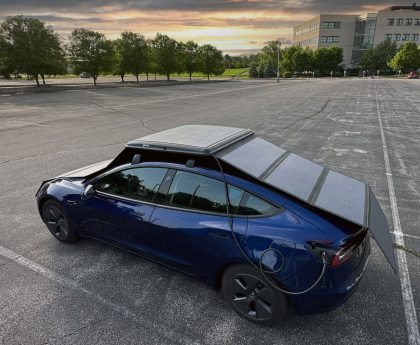The breakthrough flexible solar cell maintains 98.2% of its initial performance after 3,000 bending cycles, demonstrating high durability and reliability.
Updated: Jun 25, 2024 09:56 AM EST

An artist’s impression of flexible solar cells.
In a world first, a team of scientists has successfully developed the first flexible perovskite/silicon tandem solar cell with a record efficiency of 22.8 percent.
While other scientists have developed flexible solar cells before, the new efficiency record sets a new precedent and represents a big step forward for the technology.
It shows that flexible perovskite/silicon tandem solar cells are feasible, meaning they could soon be used for a large variety of applications.
A flexible solar cell breakthrough
Perovskite solar cells offer great advantages for developing low-cost, high-efficiency solar panels. To date, scientists have achieved efficiencies as high as 33.9 percent with rigid perovskite/silicon tandem solar cells. However, the development of flexible versions of these cells has been understandably slower.
Improving light absorption in the ultrathin silicon bottom cells, without compromising their flexibility, has proved to be challenging.
In a new paper, scientists from the Ningbo Institute of Materials Technology and Engineering, Chinese Academy of Sciences have provided details on their new flexible perovskite/silicon tandem solar cell.
It is the first flexible perovskite/silicon tandem solar cell based on ultrathin silicon, with a thickness of roughly 30 µm. A µm is a micrometer, which is equivalent to one millionth of a meter.
The scientists were able to significantly improve the flexibility of the solar cell’s silicon substrate without reducing light absorption. They reduced wafer thickness and also adjusted the feature sizes of light-trapping textures.
They also capped the perovskite top cells, which improved the mechanical durability of the material. This addressed concerns over fractures in the surface of the solar cell.
New flexible solar cell efficiency record
In tests, the scientists showed that their flexible perovskite/silicon tandem solar cell achieved a certified stabilized efficiency of 22.8 percent. That is a record efficiency for flexible solar cells.
Their flexible solar cell also has a power-to-weight ratio of 3.12 W g−1. Crucially, it also has a high bending durability. It maintains 98.2 percent of the initial performance after undergoing 3,000 bending cycles.
The new study showcases the feasibility of flexible perovskite/silicon tandem solar cells, which could open up a whole host of new applications in different fields. These include use as solar panels on sea vessels, for lighting in outdoor areas, and as a power source on windows.
RECOMMENDED ARTICLES
According to a report from SciTechDaily, The study was funded by the National Natural Science Foundation of China, the National Key Research and Development of China, and The Key Research and Development Program of Ningbo.
In February, scientists from the Jiangsu University of Science and Technology (JUST) in China announced the development of silicon-based solar cells. While these solar cells were thinner than a sheet of paper, their efficiency was lower.
The Blueprint Daily
Stay up-to-date on engineering, tech, space, and science news with The Blueprint.
ABOUT THE EDITOR
Chris Young Chris Young is a journalist, copywriter, blogger and tech geek at heart who’s reported on the likes of the Mobile World Congress, written for Lifehack, The Culture Trip, Flydoscope and some of the world’s biggest tech companies, including NEC and Thales, about robots, satellites and other world-changing innovations.
POPULAR ARTICLES
RELATED ARTICLES
This post was originally published on 3rd party site mentioned in the title of this site






